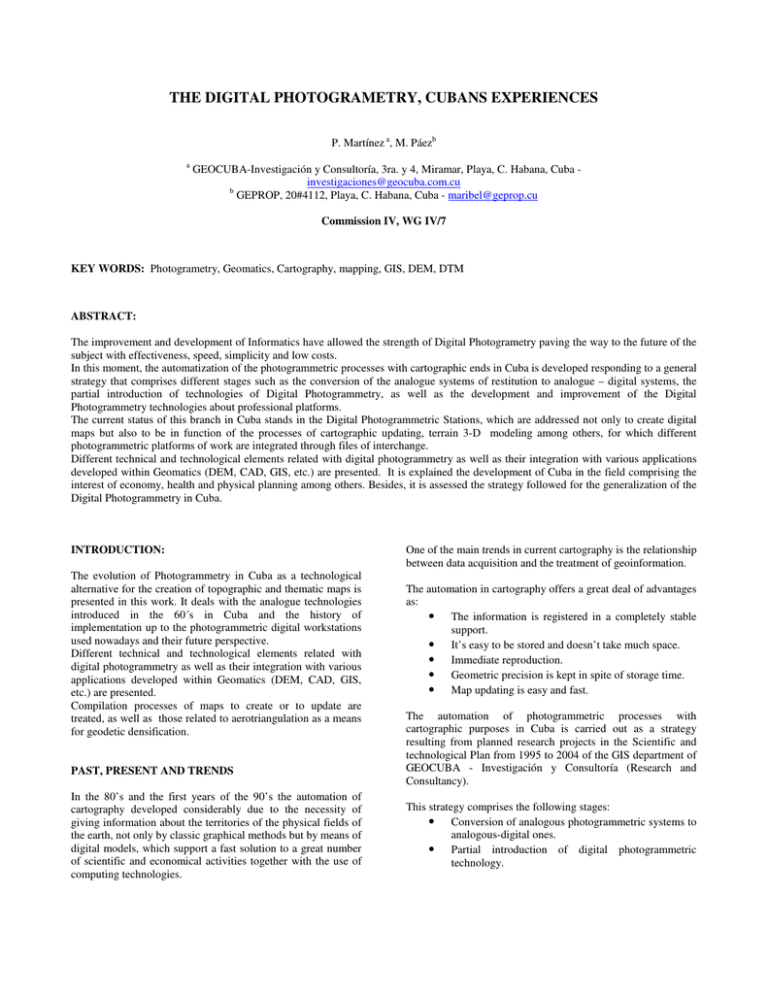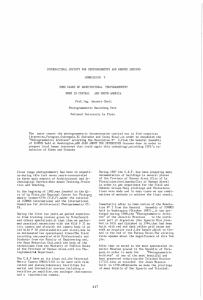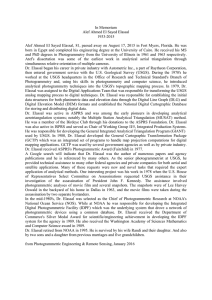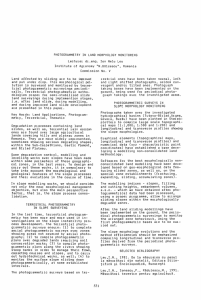THE DIGITAL PHOTOGRAMETRY, CUBANS EXPERIENCES
advertisement

THE DIGITAL PHOTOGRAMETRY, CUBANS EXPERIENCES P. Martínez a, M. Páezb a GEOCUBA-Investigación y Consultoría, 3ra. y 4, Miramar, Playa, C. Habana, Cuba investigaciones@geocuba.com.cu b GEPROP, 20#4112, Playa, C. Habana, Cuba - maribel@geprop.cu Commission IV, WG IV/7 KEY WORDS: Photogrametry, Geomatics, Cartography, mapping, GIS, DEM, DTM ABSTRACT: The improvement and development of Informatics have allowed the strength of Digital Photogrametry paving the way to the future of the subject with effectiveness, speed, simplicity and low costs. In this moment, the automatization of the photogrammetric processes with cartographic ends in Cuba is developed responding to a general strategy that comprises different stages such as the conversion of the analogue systems of restitution to analogue – digital systems, the partial introduction of technologies of Digital Photogrammetry, as well as the development and improvement of the Digital Photogrammetry technologies about professional platforms. The current status of this branch in Cuba stands in the Digital Photogrammetric Stations, which are addressed not only to create digital maps but also to be in function of the processes of cartographic updating, terrain 3-D modeling among others, for which different photogrammetric platforms of work are integrated through files of interchange. Different technical and technological elements related with digital photogrammetry as well as their integration with various applications developed within Geomatics (DEM, CAD, GIS, etc.) are presented. It is explained the development of Cuba in the field comprising the interest of economy, health and physical planning among others. Besides, it is assessed the strategy followed for the generalization of the Digital Photogrammetry in Cuba. INTRODUCTION: The evolution of Photogrammetry in Cuba as a technological alternative for the creation of topographic and thematic maps is presented in this work. It deals with the analogue technologies introduced in the 60´s in Cuba and the history of implementation up to the photogrammetric digital workstations used nowadays and their future perspective. Different technical and technological elements related with digital photogrammetry as well as their integration with various applications developed within Geomatics (DEM, CAD, GIS, etc.) are presented. Compilation processes of maps to create or to update are treated, as well as those related to aerotriangulation as a means for geodetic densification. PAST, PRESENT AND TRENDS In the 80’s and the first years of the 90’s the automation of cartography developed considerably due to the necessity of giving information about the territories of the physical fields of the earth, not only by classic graphical methods but by means of digital models, which support a fast solution to a great number of scientific and economical activities together with the use of computing technologies. One of the main trends in current cartography is the relationship between data acquisition and the treatment of geoinformation. The automation in cartography offers a great deal of advantages as: • The information is registered in a completely stable support. • It’s easy to be stored and doesn’t take much space. • Immediate reproduction. • Geometric precision is kept in spite of storage time. • Map updating is easy and fast. The automation of photogrammetric processes with cartographic purposes in Cuba is carried out as a strategy resulting from planned research projects in the Scientific and technological Plan from 1995 to 2004 of the GIS department of GEOCUBA - Investigación y Consultoría (Research and Consultancy). This strategy comprises the following stages: • Conversion of analogous photogrammetric systems to analogous-digital ones. • Partial introduction of digital photogrammetric technology. • Development and updating of digital photogrammetric technologies over professional platforms. Information Systems (GIS/ LIS). The final version may take the shape of vector line maps, digital terrain model (DTM) data, digital Ortho-Image, among others. These stages are bound to the conditions in which photogrammetry has evolved in our country as we state as follows: The DPW consists on a workstation for the graphic images management that has powerful memory and great capacity of data lodging including the possibility of stereo- imaging and the proper software to support the photogrammetric performance. • • • • • The city of Havana accounts for a stock of universal photogrammetric equipments from WLID (LEICA) with 25 to 30 years of use, which are technologically off limit. The universal photogrammetric Russian equipments in different parts of the country is obsolete since the photo format they use is 18x18cm. The stock of aerocameras for 23x23cm and 18x18cm formats are calibrated. The photogrammetric equipments to carry out differential transformation and the stock for photomechanical transformation are limited. There is not an advanced analytical aerotriangulation technology. Provided this complex reality, the development of the automation of photogrammetry and the realization of its main objective digital photogrammetry, have faced in almost all the provinces what was stated before. In the case of analogous systems from WILD (LEICA) they are assisted by personal computers, beginning to introduce in this way, analogous-digital technologies which conclude in digital photogrammetric products following international standards. Nevertheless, in our concern, this procedure should not be applied to Russian equipments although some enterprises have used it in order to take advantage of the available equipments. With this technology, the internal and relative orientation processes are made in analogue way in the equipment, and the external orientation is solved analytically for the model, creating a spatial mathematical model of the area to be restituted. The restitution is achieved with the conventional methods, except that the graphic representation of the elements that are being obtained is stored with the geodetic coordinates of each vertex and the code of each element. With this aim, it was acquired the analogue – digital restitution system ECHART which was created by LEICA and that was designed to work graphically in exchange with the program through Menu selections and dialogue boxes. The release stage or outcome is done on the basis of Computing Assisted Design CAD that allows enormous possibilities for the digital graphic workflow and the association of the design with the informative systems. In the last 15 years, it has been developed the Digital Photogrammetric Systems (DPS), which have been created for the research groups of some European Universities that have as principal element the Digital Photogrammetric Workstation. It requires photogrammetric operations that may be introduced in Digital Cartography Systems, CAD Systems, Geographical Therefore, it has become an urgent need in GEOCUBA enterprises to give priority to digital photogrammetric systems. Different technologies have been developed (limited and experimentally) assessing this problem. There will be a significant change in the near future. A few time ago, our country was provided with the technology of this kind that consists on up-to-date digital workstations, this gives us a leading position in the branch in the area. Also, it enables offering leading-edge technology services of high quality to costumers with different interests, needs, and procedences. The digital technology has, advantages: • • • • • • • • among others, the following Dimensional stability of the digital images (no environment affecting, no direct handing) and stability in the measurement system since it needs calibration. Visualization: There are no optical- mechanical requirements. The images can be visualized and measured making use of data collectors with standards devices. Image management: The image can be improved (brightness and contrast tracking, among others) to optimize its visualization. The digital images can be transferred in a quick and simple way through nets. Also it is possible to operate with them in the same sequence, on the same photogram. Automatisms can be done in the different photogrammetric processes (EOI/EOE), automatic restitution of land, etc..) The derivative products are also obtained in digital format (DIT, Digital Maps, Orthophotos, among others...) Versatility: Images are processed coming from different sensors and in different scales. Traditional restitution with automatic guidance of the Z axis. In this way it will be necessary to continue deepening in the different research studies in the digital stations during these years as well as in obtaining advanced software in the field in order to invert the situation. The methods for obtaining aerodata, with the use of modern cameras with compensation imagery and GPS data registering and the use of regular satellite imagery should be taken into account since this is a line of future development too. If we evaluate the automation of photogrammetric processes with cartographic purposes in Cuba it could be observed that there have been a technological culture in all its development, a technical personnel prepared for the activity and equipment which have made possible a steady and ongoing development. An important element to consider is the project for the creation of digital cartography at 1:25000 scale of the Republic of Cuba since it requires of photogrammetric techniques which are the basis for the development of upgrading processes and even the creation of nomenclatures, aspects that are always necessary in digital terms. In the technologies for the development of analytical aerotriangulation as part of photogrammetric processes there have also been outstanding qualitative advances, for in the first decade of the 80’s, it was introduced in Cuba for the first time in computers EC-1035. The programs allowed developing the adjustments in line and in blocks confidently. Two years ago, aerotriangulation was introduced on personal computers favoring productivity, quality and reducing costs with the same confidence. References from Journals: Petrie, G., 1990. Developments of Analytic Instrumentations Photogrammetry and Remote Sensing Magazine, 45(1). References from Books: Raíces, V.O., 1980. Aerial Photogrammetry for engineers. Facultad de la Universidad de La Habana, La Habana. References from Other Literature: Martínez, P., 1996. Diseño de los métodos para el procesamiento fotogramétrico-analítico digital de imágenes cósmicas. Tesis en opción al grado científico de Doctor en Ciencias Técnicas. Piña, P.B., 1994. Evolución en la captura y el tratamiento de la información geográfica. Instituto Geográfico Nacional de España. CONCLUSIONS: Analytical and digital photogrammetry have evolved photogrammetry because of its technological transformation, all this has been possible thanks to the development of electronics and computing. In this way photogrammetry has become a reasonable and decentralized activity, it is an easy and accessible tool for all the specialists who deal with geomatics. The golden age of traditional photogrammetric equipments in Cuba lasted up to the last decade of the 90’s when photogrammetric digital stations began to substitute them due to their high confidence level, low cost and easy to handle equipment.







